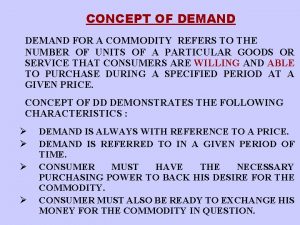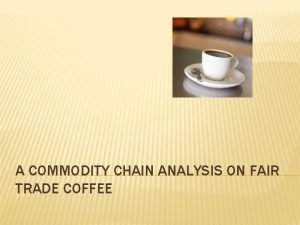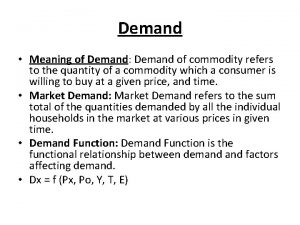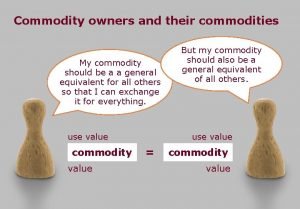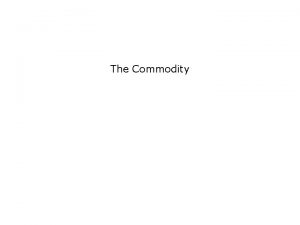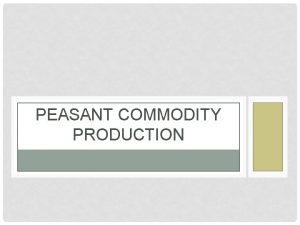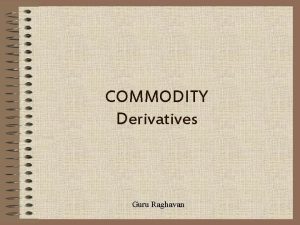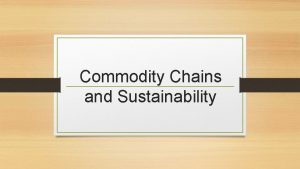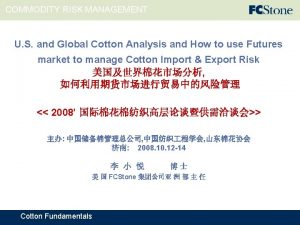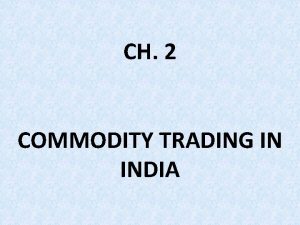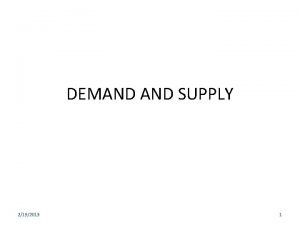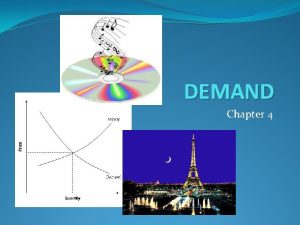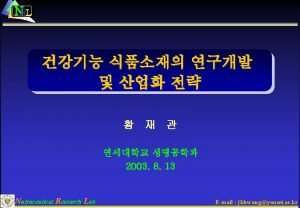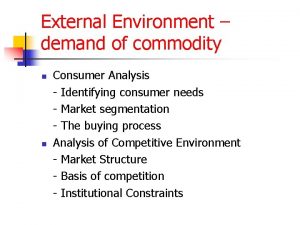Chapter 5 Demand Analysis Demand for a commodity




































- Slides: 36

Chapter 5: Demand Analysis

Demand for a commodity refers to the quantity of the commodity which an individual household is willing to purchase per unit of time at a particular price. Demand for a commodity implies: (a) Desire to acquire it, (b) Willingness to pay for it, and (c) Ability to pay for it. n

Law of Demand Marshall law states that, all other factors being equal, as the price of a good or service increases, consumer demand for the good or service will decrease and vice versa.

Exceptions to law of demand 1. 2. 3. 4. 5. Giffen goods: Inferior goods on which the consumer spends a large part of his income and the demand for which falls with a fall in their price. A rise in their price drains their resources and the poor have to shift their consumption from the more expensive goods to the giffen goods. Articles of snob appeal: Goods which serve ' status symbol ' do not follow the law of demand. These are goods of ' conspicuous consumption. Expectations regarding future prices: If the price of a commodity is rising and is expected to rise in future the demand for the commodity will increase. Emergency: At times of war, famine etc. consumers have an abnormal behaviour. Quality-price relationship: People assume that expensive goods are of a higher quality then the low priced goods.

Demand Schedule

Demand Curve

Market Demand u. Market demand refers to the sum of all individual demands for a particular good or service. u. Graphically, individual demand curves are summed horizontally to obtain the market demand curve.

Demand functions äsimple demand functions Qd = a – b. P ämore complex demand functions Qd = a – b. P + c. Y + d. Ps – e. Pc

Demand curve for equation: Qd = 10 000 – 200 P P D Q (000 s)

Demand curve for equation: Qd = 10 000 – 200 P P Qd (000 s) 5 9 P D Q (000 s)

Demand curve for equation: Qd = 10 000 – 200 P P Qd (000 s) 5 10 9 8 P D Q (000 s)

Demand curve for equation: Qd = 10 000 – 200 P P Qd (000 s) 5 10 15 9 8 7 P D Q (000 s)

Demand curve for equation: Qd = 10 000 – 200 P P P Qd (000 s) 5 10 15 20 9 8 7 6 D Q (000 s)

Prices of Related Goods Substitutes & Complements u. When a fall in the price of one good reduces the demand for another good, the two goods are called substitutes. (Tea & Coffee) u. When a fall in the price of one good increases the demand for another good, the two goods are called complements. (Car & Petrol)

Determinants of demand äTastes & Preferences änumber and price of substitute goods änumber and price of complementary goods äIncome (Taxes & Subsidies) äAdvertisings äExpectations äSeasonal Variations äPopulation

Determinants of demand

Impact of Demand determinant

Impact of Demand determinant

Two Simple Rules for Movements vs. Shifts n Rule One ä When an independent variable changes and that variable does not appear on the graph, the curve on the graph will shift. n Rule Two ä When an independent variable does appear on the graph, the curve on the graph will not shift, instead a movement along the existing curve will occur. n Let’s apply these rules to the following cases of demand!

Change in Quantity Demanded versus Change in Demand Change in Quantity Demanded u Movement along the demand curve. u Caused by a change in the price of the product.

Price of Cigarettes per Pack $4. 00 Changes in Quantity Demanded A tax that raises the price of cigarettes results in a movement along the demand curve. C A 2. 00 D 1 0 12 20 Number of Cigarettes Smoked per Day

Change in Quantity Demanded versus Change in Demand u A shift in the demand curve, either to the left or right. u Caused by a change in a determinant other than the price.

Consumer Income Price of Ice -Cream Cone Normal Good An increase in income. . . $3. 00 2. 50 Increase in demand 2. 00 1. 50 1. 00 0. 50 D 1 0 1 2 3 4 5 6 7 8 9 10 11 12 D 2 Quantity of Ice-Cream Cones

Consumer Income Price of Ice -Cream Cone Inferior Good $3. 00 An increase in income. . . 2. 50 2. 00 Decrease in demand 1. 50 1. 00 0. 50 D 2 0 1 D 1 2 3 4 5 6 7 8 9 10 11 12 Quantity of Ice-Cream Cones

Change in Quantity Demanded versus Change in Demand Variables that Affect Quantity Demanded A Change in This Variable. . . Price Represents a movement along the demand curve Income Shifts the demand curve Prices of related goods Shifts the demand curve Tastes Shifts the demand curve Expectations Shifts the demand curve Number of buyers Shifts the demand curve

Substitution & Income effect In the two goods - two prices analysis, the effect of a change in the price of one of the goods is generally decomposed into the substitution effect and the income effect. n The substitution effect is Change in the quantity of that good consumed when the budget constraint reflects the new relative prices n The income effect is Change in consumption of a good resulting strictly from a change in purchasing power

Why does the Demand Curve Slope Downward? n Law of Demand äInverse relationship between price and quantity. n Law of Diminishing Marginal Utility. äUtility is the extra satisfaction that one receives from consuming a product. äMarginal means extra. äDiminishing means decreasing.

MARGINAL UTILITY THEORY n Total and marginal utility ämeaning of total utility ämarginal utility: TU/ Q • diminishing marginal utility ätotal and marginal utility curves

Utility (utils) Darren’s utility from consuming crisps (daily) Packets of crisps TU in utils 0 1 2 3 4 5 6 0 7 11 13 14 14 13 Packets of crisps consumed (per day)

Utility (utils) Darren’s utility from consuming crisps (daily)TU Packets of crisps TU in utils 0 1 2 3 4 5 6 0 7 11 13 14 14 13 Packets of crisps consumed (per day)

Darren’s utility from consuming crisps (daily)TU Utility (utils) MU Packets TU of crisps in utils 0 1 2 3 4 5 6 0 7 11 13 14 14 13 Packets of crisps consumed (per day) 7 4 2 1 0 -1

Darren’s utility from consuming crisps (daily)TU Utility (utils) MU Packets TU of crisps in utils 0 1 2 3 4 5 6 0 7 11 13 14 14 13 7 4 2 1 0 -1 MU Packets of crisps consumed (per day)

Darren’s utility from consuming crisps (daily)TU Utility (utils) DTU = 2 DQ = 1 MU = DTU / DQ MU Packets of crisps consumed (per day)

Darren’s utility from consuming crisps (daily)TU Utility (utils) DTU = 2 DQ = 1 MU = DTU / DQ = 2/1 = 2 MU Packets of crisps consumed (per day)

Why does the Demand Curve Slope Downward? Marginal Utility Theory n Fall in price – extra income (Income effect) n Substitution effect n Cheaper price – new consumers n

Revenue Concepts n Total Revenue: • TR = P * Q n Average Revenue • AR = TR/Q = (P*Q)/Q = P n Marginal Revenue • MRn = TRn – TRn-1 OR • MRn = d(TR)/d. Q
 Demand for a commodity refer to
Demand for a commodity refer to Coffee commodity chain
Coffee commodity chain Commodity chain example
Commodity chain example Iso 22301 utbildning
Iso 22301 utbildning Novell typiska drag
Novell typiska drag Tack för att ni lyssnade bild
Tack för att ni lyssnade bild Returpilarna
Returpilarna Varför kallas perioden 1918-1939 för mellankrigstiden
Varför kallas perioden 1918-1939 för mellankrigstiden En lathund för arbete med kontinuitetshantering
En lathund för arbete med kontinuitetshantering Särskild löneskatt för pensionskostnader
Särskild löneskatt för pensionskostnader Tidbok yrkesförare
Tidbok yrkesförare A gastrica
A gastrica Förklara densitet för barn
Förklara densitet för barn Datorkunskap för nybörjare
Datorkunskap för nybörjare Tack för att ni lyssnade bild
Tack för att ni lyssnade bild Tes debattartikel
Tes debattartikel Autokratiskt ledarskap
Autokratiskt ledarskap Nyckelkompetenser för livslångt lärande
Nyckelkompetenser för livslångt lärande Påbyggnader för flakfordon
Påbyggnader för flakfordon Vätsketryck formel
Vätsketryck formel Svenskt ramverk för digital samverkan
Svenskt ramverk för digital samverkan Bo bergman jag fryser om dina händer
Bo bergman jag fryser om dina händer Presentera för publik crossboss
Presentera för publik crossboss Vad är ett minoritetsspråk
Vad är ett minoritetsspråk Bat mitza
Bat mitza Klassificeringsstruktur för kommunala verksamheter
Klassificeringsstruktur för kommunala verksamheter Epiteltyper
Epiteltyper Bästa kameran för astrofoto
Bästa kameran för astrofoto Cks
Cks Verifikationsplan
Verifikationsplan Mat för idrottare
Mat för idrottare Verktyg för automatisering av utbetalningar
Verktyg för automatisering av utbetalningar Rutin för avvikelsehantering
Rutin för avvikelsehantering Smärtskolan kunskap för livet
Smärtskolan kunskap för livet Ministerstyre för och nackdelar
Ministerstyre för och nackdelar Tack för att ni har lyssnat
Tack för att ni har lyssnat Referat mall
Referat mall
